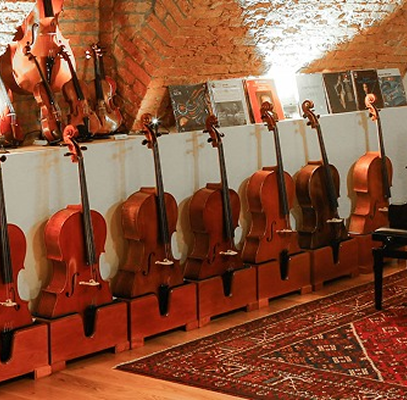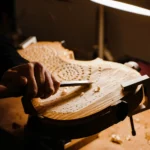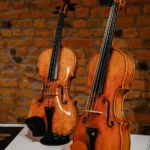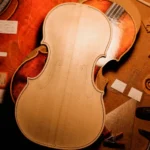Violin Acoustics, Plate Tuning, and the Science Behind Great Tones
Back to BlogVoice of the Violin: Violin Acoustics, Plate Tuning, and the Science Behind Great Tones
For the untrained observer, a violin is an object of beauty. But for those who know how to listen, it possesses much more. That beauty is the result of two factors over which the maker has some control (but not nearly as much as you’d think): craftsmanship and the science of acoustics. The violin’s tone is the real measure of its worth—it’s what makes a good violin a great one. It’s careful balancing act makes the violin not only the most popular orchestral instrument but also the one with the most far-reaching solo repertoire.
The Soul of the Sound: Why Violin Acoustics Matter
The foundation of a player’s voice lies in the acoustics of the violin. It is not just about the volume or the clarity of sound produced—it is about the warmth, the nuance, and the responsiveness of the instrument. Whether in the hands of a soloist on stage or in a practice room with a student, a violin’s acoustics determine how easily it speaks and how well it sings.
Every component of the instrument, from the spruce of its top plate to the arch of its back, makes a different sound when finely tuned. The elements resonate in harmony, producing a tone that can soar, whisper, or weep. For luthiers and players alike, understanding violin acoustics is the key to unlocking that tonal poetry.
Materials That Sing: The Role of Wood and Density
The finest violins start with the finest wood. But even in tonewoods, not all wood is created equal. The spruce for the top plate needs to be light yet powerful. The maple for the back and ribs needs to provide stiffness and give so that it can reflect and add depth to the vibrations from the top. Wood density is a critical factor in violin acoustics. Too dense, and the sound is shrill. Too soft, and it does not project. Luthiers tap and density-measure raw materials before carving.
The Science Beneath the Strings: An Introduction to Plate Tuning
Plate tuning is one of the most essential methods used by luthiers to achieve the desired acoustical properties of a violin. This technique involves shaping the top and back plates of a violin, as well as determining their optimal thickness, so that these components will vibrate in a way that produces musically pleasing results. Finding the perfect “tune” for a violin can take many hours of meticulous trial and error
Luthiers sometimes use a technique known as tapping to help acertain the tonal characteristics of a particular batch of wood. The key to a beautiful sound in an instrument lies in the precise tuning of its top and bottom plates. As a maker percusses the plates, he or she listens closely for amplitude and clarity. The goal is to align the notes of the upper and lower regions with those in the central area—creating a clean, sharp tone that projects effortlessly. But above all, tuning is about developing the ear. This intimate step in the making process reveals subtle nuances only experience can catch.
Just like the great masters of the past, we rely on hearing alone to achieve the perfect result. When performed with precision, plate tuning transcends science and becomes an art. The toiler at the bench is not just listening with the ear; he or she is also listening with the fingertips and heart. The end result is more a matter of intuition than one of reason.
The Bridge and Soundpost: Acoustic Heart of the Violin
Consider the bridge and soundpost as the inner conversation of the violin. The bridge transmits the vibration of strings into the body, and the soundpost—a thin wooden part hidden between the top and back plates—aids in distributing these vibrations and maintaining balance of tone.
An adjustment of a millimeter in soundpost placement can alter a violin’s voice. Nudge it north, and the tone is brighter. Move it south, and the violin might become warmer or darker. The science of placing the soundpost is acoustic engineering at its best, and intensely intimate to each individual instrument. Great luthiers know that the violin’s voice is not static. It evolves. Humidity, temperature, and even the player’s touch affect how the instrument behaves.
Vibrations and Modes: Mapping the Voice of the Violin
Acoustic scientists have spent decades charting the violin’s intricate patterns of vibration with instruments such as modal analysis and laser vibrometry. What these studies show is how the various parts of the violin body vibrate during performance and contribute to certain frequency ranges and color of tones. This scientific understanding does not substitute the luthier’s intuition; it supports it. In fact, most leading makers, such as Luiz Amorim, cleverly weave these findings into centuries-old methods to produce instruments that respect history and adopt innovation.
Varnish: More Than a Pretty Finish
Varnish does more than guarding the surface of a violin—it quietly influences tone. A varnish that is too thick can subdue vibrations, while too soft a varnish might not sustain under the demands of the structure.
The finest luthiers formulate their own varnish mixtures, applying them in layers and letting them cure naturally to bring out the wood’s natural voice. This results in a violin that does not boast an aesthetic quality but a tonal quality so that the violin can breathe and sing with ease.
The Player’s Touch: The Acoustic Equation
While the construction provides the basis, it is the bow that stimulates a violin into motion. No matter how acoustically perfect a violin, its real voice becomes prominent only under a musician who stretches out its inner soul. It’s as if there is a feedback loop at work between human touch and vibrating wood, and this is unarguably the most intimate relationship in the music world.
No wonder, quite many professional players select the instrument as much by feel as by ear. A responsive violin not only produces the perfect tone but is sensitive to the pressures and impulses exerted on it. The great Cremonese makers of the era, such as Antonio Stradivari and Giuseppe Guarneri, learned violin acoustics the hard way, drawing upon both their experience and brains.
Contemporary luthiers, such as Luiz Amorim, don’t simply imitate the past, but build upon it. Whether it’s a centuries-old Strad or a freshly minted Amorim, there is one thing that is found in all great violins- a voice that stirs the soul.
Conclusion: The Living Voice of the Violin
Ultimately, violin acoustics is not merely a question of equation or engineering. It’s more about fostering a connection between wood and maker, between bow and string and most importantly between player and listener. Every great violin seeks to initiate a dialogue between science and art—reflecting what happens when precision and passion collide.
The next time you listen to a violin sing, then, remember that you’re not merely listening to strings on wood. In reality, it is a glowing tribute to centuries of craftsmanship and science—brought to life in every note. At Amorim Fine Violins, we expertly craft violins for both sound and soul. Explore our Amorim collection or schedule a tryout with the Amorim team and see for yourself how each instrument promises the best of music.









